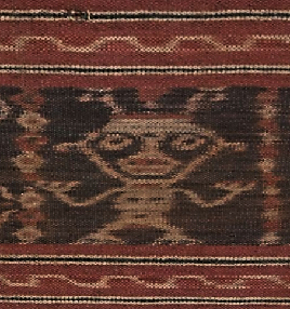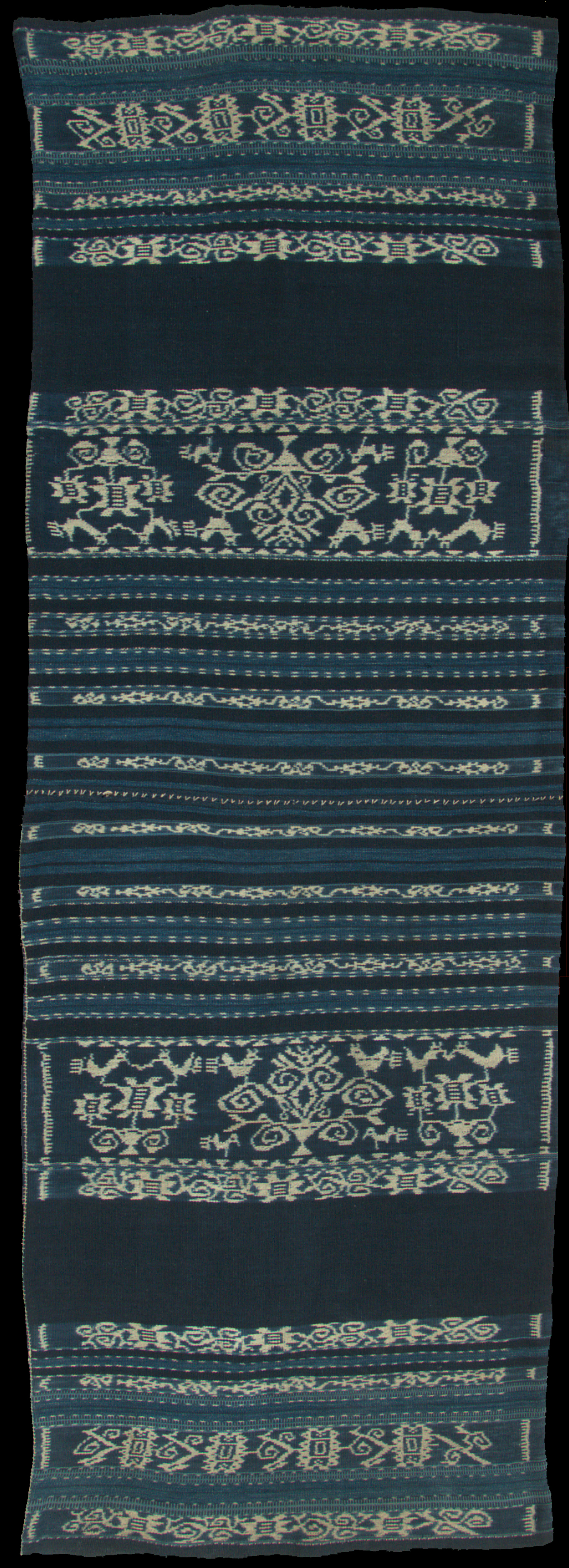| |
 mouse over to magnify mouse over to magnify
| | | | 012 Savu Group, Savu
Ei (sarong)
| | Locale: | | | Period: | 1925-1945 | | Panels: | 2 | | Design: | Ei worapi with stunning 'free' pattern (i.e. not restricted to either of the moieties), in white on dark, deeply saturated indigo. The pattern contains a visual device, an illusion: the smaller motifs in the widest ikated bands are reversible. In the lower part of the sarong it appears to be a typical example of a Savunese sarong with motifs, inspired by European needlework patterns: vases with floral arrangements, small birds perched on either side. But in the upper part of the sarong, flipped vertically, it has turned into an anthropomorphic figure with bulging eyes and a 'Martian' aspect such as seen on old Minahasa ikat. The rake-shaped tails of the birds have turned into feet with toes, explicitly rendered, as on Timor, Kisar, Luang. The narrower ikated bands are decorated with eight-pointed stars in an odd rendering, interwoven into what appear to be floral motifs. | | Size: | 53 x 154 cm (20.8 x 60.6 in) | | Weight: | 515 g (315 g/m2) | | Yarn: | Cotton, hand-spun, fine, and commercial thread, both double-ply | | Comment: | This is a textbook example of competitive ikat. It stands out not just by its clever visual trickery, but also by its sharp, unusually angular drawing type, which is not often seen on Savu. (It is seen on men's shawl PC 172, which was acquired from the same source, and may well have been made by the same weaver, given that this style is quite eccentric.) The extremities have three ribbed accent stripes in supplementary weft. A cloth like this with motifs from outside the traditional canon, inspired at least in part by crochet patterns distributed by Dutch missionaries in the early 20th C., may not be used on ceremonial occasions, and is reserved for informal wear. Microscopic inspection yielded unexpected ethnographic data.
Remarkably, the ikat work (the 'posh' part) was all done on commercial thread, whereas the plain areas were done in very fine hand-spun. This suggests that on Savu at that particular time commercial thread - which allowed very precise ikat - was considered a luxury, something one would not waste on plain sections. As commercial thread began to become a commodity at the latest by the late 1940s, this cloth should probably be dated at the older end of the estimated period. | | Background: | Additional information in chapters on Savu Group and Savu. | | Published: | Ikat from Timor and its Outer Islands, 2022. | | Sources: | Cf. human figure on 19th to early 20th c. Minahasa sarong in Tropenmuseum collection, No. TM-48-13, shown below. Duggan, in neither of her two works on the ikat of Savu published so far (2001 and 2013) shows an example that is similarly angular.
 | | |
 ©Peter ten Hoopen, 2025
All rights reserved.
|
|


